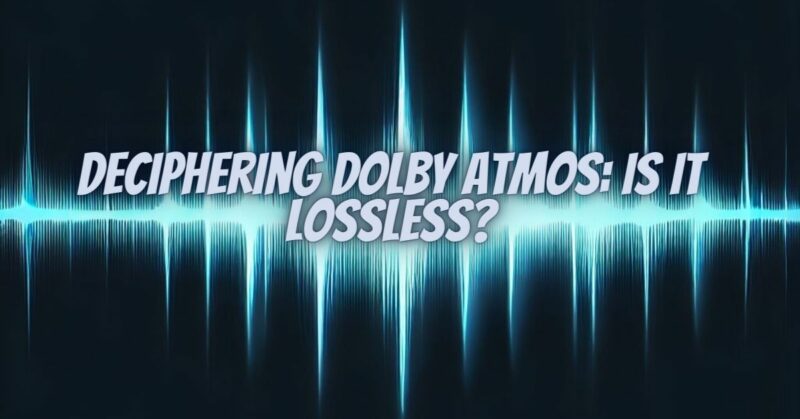Dolby Atmos has become a buzzword in the world of audio, renowned for its immersive, three-dimensional sound experience. However, there is often confusion about whether Dolby Atmos is synonymous with lossless audio. In this article, we will decipher Dolby Atmos and determine whether it qualifies as a lossless audio format.
Dolby Atmos: The Immersive Audio Technology
Dolby Atmos is an advanced audio technology developed by Dolby Laboratories. It is designed to create a more immersive and spatial audio experience by introducing height channels to the traditional surround sound setup. Here’s a closer look at Dolby Atmos:
1. Object-Based Audio: Dolby Atmos uses object-based audio, a departure from traditional channel-based audio systems. In object-based audio, sound elements (objects) are placed within a three-dimensional soundstage. This allows sound to come from any direction, including above and around the listener.
2. Height Channels: One of the defining features of Dolby Atmos is the inclusion of height channels. This means that audio objects can be placed both horizontally and vertically in space, creating a more immersive and realistic sound environment.
3. Immersive Experience: Dolby Atmos excels in creating an immersive sound experience, making it particularly popular in cinema, home theater systems, gaming, and select music tracks. It adds depth and dimension to audio, enhancing the overall entertainment experience.
Lossless Audio: Preserving Original Fidelity
Lossless audio refers to audio formats that do not compress audio data, ensuring that the playback is a perfect replica of the original recording. Common lossless formats include FLAC (Free Lossless Audio Codec) and WAV (Waveform Audio File Format). Key characteristics of lossless audio include:
1. Uncompromising Fidelity: Lossless audio formats capture and reproduce every detail of the original recording without any compression. This ensures that the sound heard by the listener is an exact replica of the source.
2. High Bit Depth and Sample Rate: Lossless formats often use a bit depth of 24 bits or more and higher sample rates (e.g., 96 kHz). These specifications provide a wider dynamic range and greater audio detail than standard CD quality.
3. Audiophile Appeal: Lossless audio is favored by audiophiles and music enthusiasts who prioritize audio quality above all else. It delivers pristine and studio-quality sound.
Is Dolby Atmos Lossless?
Dolby Atmos, by its nature, focuses on creating an immersive and spatial audio experience. While it offers exceptional audio quality and immersion, it does not qualify as a lossless audio format. Here’s why:
- Compression: Dolby Atmos content, whether in movies, gaming, or music, is typically compressed to some extent to reduce file sizes. Compression, even if it’s minimal, involves some data reduction, which is a departure from the lossless principle of capturing every detail.
- Object-Based vs. Bitstream: Dolby Atmos primarily relies on bitstream audio encoding to carry the object-based audio information. This is different from lossless formats like FLAC or WAV, which store uncompressed audio samples.
- Use Case: Dolby Atmos is designed for immersive entertainment experiences, emphasizing spatial audio and immersion. Lossless audio formats, on the other hand, prioritize preserving the original audio fidelity without spatial enhancements.
In summary, Dolby Atmos and lossless audio serve different purposes. Dolby Atmos is a technology aimed at creating an immersive audio experience, while lossless audio formats prioritize audio fidelity. While Dolby Atmos is not considered a lossless format, it remains a powerful and compelling technology for those seeking a more immersive and spatial audio experience in their entertainment. Whether you choose Dolby Atmos or lossless audio depends on your specific audio preferences and use cases.


